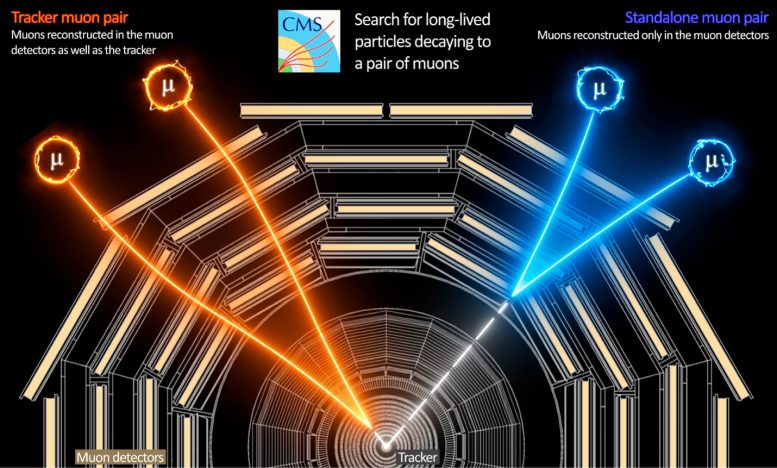
Illustration of two types of long-lived particles decaying into a pair of muons, showing how muon signals can be traced back to the point of long-lived particle decay using data from tracers and muon detectors. Credit: CMS/CERN
This search for long-lived exotic particles investigates the possibility of a “dark” event. Photon“Production, which may occur when the Higgs boson decays into displaced muons in the detector.
The CMS experiment provided its first search for new physics using data from Run 3 of the Large Hadron Collider. The new study investigates the possibility of producing a “dark photon” in the decay of Higgs bosons in the detector. Dark photons are exotic, long-lived particles: “long-lived” because their average lifetime is more than a tenth of a billionth of a second — an extremely long lifetime for particles produced at the Large Hadron Collider — and “strange” because they are not part of the Standard Model of particle physics. .
The Standard Model is the leading theory of the basic building blocks of the universe, but many physical questions remain unanswered, and thus the search for phenomena outside the Standard Model continues. The new CMS result sets more restrictive bounds on the decay variables of Higgs bosons into dark photons, further narrowing the region in which physicists can search.
Dark photon theory and particle detection
In theory, dark photons would travel a measurable distance in the CMS detector before decaying into “displaced muons.” If scientists trace the paths of these muons, they will find that they do not reach the point of impact, because the paths come from a particle that has already moved some distance, without any trace.
The LHC's third run began in July 2022, and it has a higher instantaneous luminosity than previous LHC runs, meaning there are more collisions occurring at any given moment for researchers to analyse. The LHC produces tens of millions of collisions every second, but only a few thousand of them can be stored, as recording each collision would quickly consume all available data storage space. That's why the CMS is equipped with a real-time data selection algorithm called a trigger, which decides whether a particular collision is interesting or not. Therefore, it is not only the large volume of data that can help uncover evidence of a dark photon, but also the way the trigger system is tuned to search for specific phenomena.
Advances in trigger system and data collection
“We have already improved our ability to stimulate displaced muons,” says Juliette Alemina of the CMS experiment. “This allows us to collect much more events than before using muons displaced from the point of impact by distances ranging from a few hundred micrometers to several metres. Thanks to these improvements, if dark photons are present, CMS is now more likely to find them.”
The CMS run was crucial to this research, and was particularly optimized between runs 2 and 3 for searching for long-lived foreign molecules. As a result, the collaboration was able to use the LHC more efficiently, obtaining a robust result using only a third of the amount of data from previous searches. To do this, the CMS team improved the operating system by adding a new algorithm called the unsigned muon algorithm. This improvement means that even with only four to five months of data from Run 3 in 2022, a greater number of muon displacement events were recorded than in the much larger 2016-2018 data set. The new coverage of the stimuli dramatically increases the momentum ranges of the muons captured, allowing the team to explore new regions where long-lived particles may be hiding.
Future plans and continued exploration
The CMS team will continue to use the most powerful techniques to analyze all data taken in the remaining 3 years of operations, with the aim of further exploring physics outside the Standard Model.

“Beer aficionado. Gamer. Alcohol fanatic. Evil food trailblazer. Avid bacon maven.”
